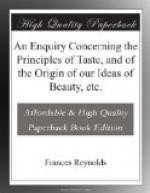Recently, however, evidence has turned up which makes the attribution a certainty. It is now obvious that Northcote must have been mistaken in the source of his quotations. Writing as he did many years after the events he was describing, Northcote either had found a copy of the first draft of Miss Reynolds’ essay, or erroneously quoted from another anonymous piece which he assumed was by Miss Reynolds. In any event he was not quoting from the final version which she wished the world to see.
The story of Miss Reynolds’ attempts to publish her essay can at last be pieced together from various bits of evidence, some hitherto unpublished. Just when the essay was written is uncertain. All that we know is that a preliminary version was submitted to the rigorous criticism of Dr. Johnson in 1781. Johnson, who had corrected some of her verses in red ink the year before, commented on 21 July 1781:
There is in these such force
of comprehension, and such nicety
of observation as Locke or
Pascal might be proud of. This I
say with intention to have
you think that I speak my opinion.
They cannot however be printed in their present state. Many of your notions seem not very clear in your own mind, many are not sufficiently developed and expanded for the common reader; the expression almost every where wants to be made clearer and smoother. You may by revisal and improvement make it a very elegant and curious work.[1]
But Miss Reynolds was not easily discouraged, and Johnson wrote again on 8 April 1782:
Your work is full of very penetrating meditation, and very forcible sentiment. I read it with a full perception of the sublime, with wonder and terrour, but I cannot think of any profit from it; it seems not born to be popular.
Your system of the mental fabric is exceedingly obscure, and without more attention than will be willingly bestowed, is unintelligible. The Ideas of Beauty will be more easily understood, and are often charming. I was delighted with the different beauty of different ages.
I would make it produce something if I could but I have indeed no hope. If a Bookseller would buy it at all, as it must be published without a name, he would give nothing for it worth your acceptance.[2]
In passing it might be pointed out that this letter has previously not been associated with Miss Reynolds’ essay on taste, largely because the available text of the letter has been so faulty. Where Johnson wrote “The Ideas of Beauty,” obviously referring to the second section of the Enquiry, Croker, followed by G.B. Hill, printed “The plans of Burnaby.” To this Hill added a note; “Burnaby, I conjecture, was a character in the book,” with the result that scholars have fruitlessly been searching ever since for the fictitious Mr. Burnaby, One more example of the dangers of using nineteenth-century transcripts!




